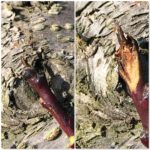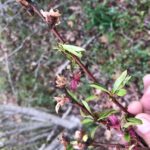Bacterial Spot is a key pest of Peach, Nectarine and Plum and in some years like 2019 can cause significant losses. It is caused by the bacterium Xanthomonas arbicola pv. pruni. Bacterial spot cankers that cause tip dieback (commonly called Black Tip) are often difficult to distinguish from cankers caused by other peach diseases. Other cankers that may appear during bloom are caused by the blossom blight phase of brown rot, and constriction canker. Black tip usually appears during or just after bloom. Typical symptoms are a gradual blackening of the tip with dead tissue moving down the twig and is often observed on highly susceptible cultivars (Fig. 1). Tip die back may also occur from abiotic factors such as frost. Tip die back from frost is often accompanied by blind wood usually 6-8 inches below the tip where leaves and flowers have fallen off after being killed by a freeze.
In some cases the twig may appear healthy and a shoot begins growing from the tip only to die back after leafing out and flowering. This is often a symptom of late winter/early spring infections of constriction canker. Many times a bud that was infected in the fall and never leafed out may be found just below the new shoot that is dying. This usually a good clue that constriction canker is the cause. These symptoms may be more prevalent in old trees that have a history of the disease (Fig. 2).
Tip cankers such as these may be accompanied by cankers on flower buds lower down the on the twig typically associated with blossom blight or constriction canker, or they may appear alone. Spring cankers from bacterial spot that form around flower buds are less commonly seen in our region. In cases like this it is difficult to diagnose the disease early on, especially where symptoms are randomly found at low levels or are mixed in appearance. The only thing that can be done is to note the trouble blocks and watch to see what develops. Blossom blight and constriction canker will eventually develop unique symptoms. Bacterial spot lesions will eventually show on the leaves. If you see black tip cankers forming during bloom its not a bad idea to assume its bacterial spot and include copper or oxytetracycline with your blossom blight sprays.


